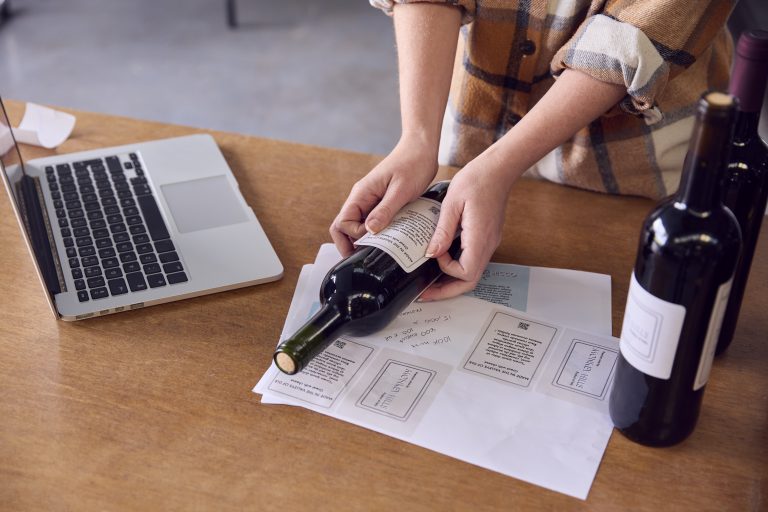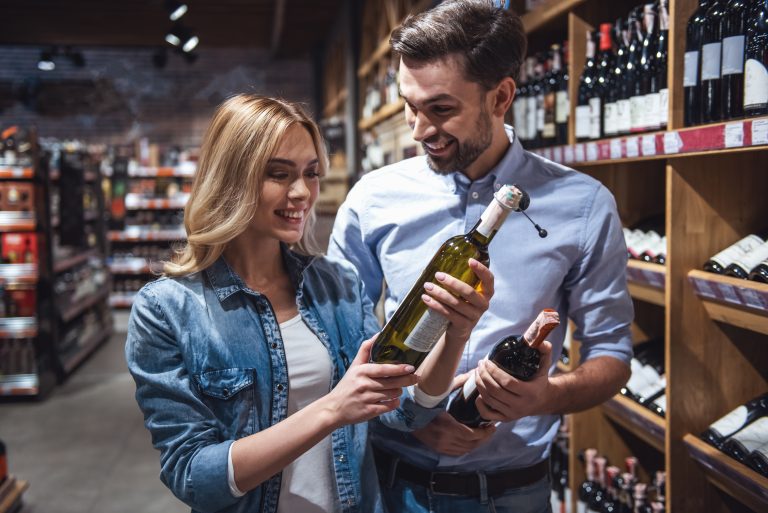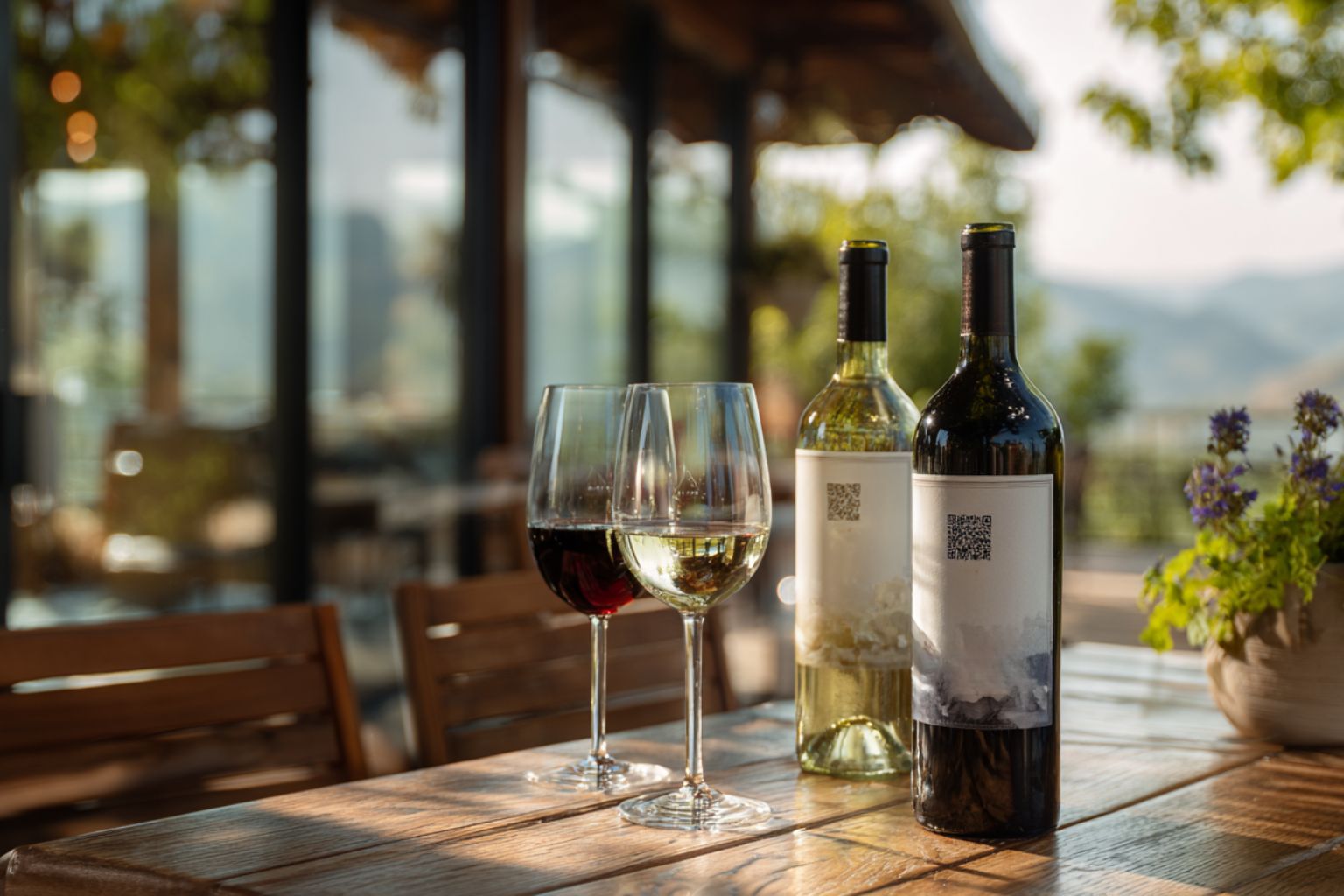A Story Told on Paper
For centuries, wine labels have been more than pieces of paper glued to bottles. They are the first handshake between wine and consumer – carrying identity, heritage, and often a touch of artistry. The typeface, the illustration, even the choice of paper all signal what lies inside.
In Romania, as in the rest of Europe, the rules for physical wine labels are strict and detailed. Every bottle must clearly display a set of mandatory indications: the category of the product (wine, sparkling, etc.), the origin (DOC or IG, when applicable), alcohol strength, country of provenance, the bottler, the importer (if relevant), volume, batch number, and allergens such as sulfites, eggs or milk proteins.
Optional mentions, such as vintage year, grape varieties, or medals awarded, enrich the story but must follow precise conditions. Even the font size for alcohol percentage is prescribed, down to millimetres depending on bottle volume. In short, the classic wine label is a legal document and a marketing tool rolled into one.
But the traditional label has its limits. Space is finite, print is static, and regulations evolve faster than design cycles. Which is why the wine world is now experimenting with a digital twin of the label: the electronic label, or e-label.
The Rise of the QR Code
The European Union took a decisive step in December 2023, making it mandatory for all wines produced or imported after that date to disclose both nutritional information and ingredients. Only part of this must appear on the physical label: energy value and allergens. The rest can be offered electronically, through a QR code printed on the bottle.
The rules are strict. The QR must be clearly visible and accompanied by a word like “Ingredients.” It must lead directly to the mandatory information, without marketing fluff, advertising, or data tracking. Translations must be available in the language of the target market. And the digital content must remain accessible for the entire lifespan of the bottle.
In practice, this means a consumer in Bucharest, Berlin or Barcelona can now scan a code and instantly see the full ingredient list, nutritional breakdown and even production details – without cluttering the physical label. The design remains elegant, while the consumer gains transparency.
Romanian producers, however, have already felt the pain of transition. Some printed millions of labels with QR codes that did not carry the required word “Ingredients.” A late interpretation from the European Commission suddenly rendered them non-compliant, threatening huge costs for reprinting. The industry association CEEV warned of a lack of legal certainty.

Lessons from the U.S.
Across the Atlantic, the debate around e-labels is heating up as well. In the United States, the Alcohol and Tobacco Tax and Trade Bureau (TTB) still requires a long list of mandatory physical indications – brand name, alcohol content, health warnings, sulfites, and country of origin, among others. Each label must be approved via the Certificate of Label Approval (COLA) before being marketed.
But the push for modernization is strong. The International Federation of Wines and Spirits (FIVS) has called on the U.S. to embrace electronic labeling as a way to provide both required and voluntary information through a single QR code. This would harmonize rules internationally, cut down printing costs, and give consumers immediate access to data on sustainability, recalls or allergens.
FIVS argues that e-labels could especially help wineries adjust to vintage variation. Unlike soft drinks or spirits, wine changes year to year. A flexible, digital system would allow producers to update ingredient or nutrition information without redesigning physical labels annually.
While U.S. regulators have yet to fully adopt the model, pressure from consumer groups, international trade, and the precedent set by the EU suggests change is coming.
Tradition vs. Technology - Or a New Partnership?
The question, then, is not whether classic labels will disappear. They won’t. They remain vital for:
- Brand identity and storytelling – the artistry that draws consumers to pick up a bottle.
- Immediate recognition – in a supermarket aisle, few people whip out their phones first.
- Legal certainty – some information must always be visible without digital access.
But electronic labels add what physical ones cannot:
- Depth of information – from full nutrition tables to traceability data.
- Flexibility – updates in real time, even after printing.
- Global harmonization – QR codes can meet multiple markets’ requirements.
- Accessibility – screen readers, larger fonts, and automatic translation.
The two systems are complementary. The physical label attracts, reassures and complies with minimal legal needs. The e-label completes the picture, offering transparency, sustainability credentials, and consumer engagement.

Romania at the Crossroads
For Romanian wine producers, the stakes are high. The domestic market still values tradition and aesthetics, but exports require compliance with EU’s new digital rules. Many wineries have already begun adopting QR codes – not just for compliance, but to tell richer stories.
Imagine scanning a bottle of Fetească Neagră and discovering:
- The vineyard parcel it came from,
- Harvest conditions in that year,
- Suggested food pairings,
- Sustainability certificates,
- Awards and press reviews.
This goes far beyond what a 10×12 cm paper label could ever hold. For younger consumers and international buyers, it signals professionalism and transparency.
Yet challenges remain. Smaller wineries worry about costs and technical know-how. Legal ambiguities, like the “Ingredients” wording debacle, add uncertainty. And there is a cultural question: will traditional wine lovers embrace digital interaction, or see it as intrusive?
A Global Shift
Globally, the trend is clear. From Italy to California, wineries are experimenting with smart labels – QR codes, NFC chips, even augmented reality experiences. Some AR apps let consumers point their phone at a label and watch the winemaker appear to tell the story.
But the regulatory frameworks differ. Europe has codified the role of e-labels in law. The U.S. is still debating. Other markets, from Canada to Japan, are watching closely. For exporters like Romania, understanding these differences is crucial.

Conclusion: The Label of the Future
Wine has always balanced heritage and innovation. Labels are no different. The parchment-styled fonts and family crests will remain, but they will be joined – discreetly – by a square black-and-white code that opens up a universe of data.
For consumers, this means greater confidence and clarity. For producers, it offers both new obligations and new opportunities: a chance to stand out not only by taste and design, but also by transparency and digital savvy.
In the end, the classic and the electronic label are not rivals. They are partners in telling the story of wine – from vineyard to glass, from tradition to tomorrow.








